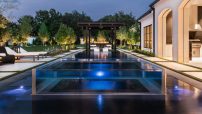Herman Goodman, an influential engineer who helped design thousands of pools in Southern California over the past half-century, died March 12. He was 89.
“He was one of the most prolific designers of pools in Southern California,” said Don Goldstone, whose firm specializes in high-end pools and often turned to Goodman for the complex engineering they required.
“Any time I ever had a question about anything — my wildest, most unusual, most peculiar pool that I was going to dream up — I would call Herman,” Goldstone said. “He was the first guy I thought of to ask, ‘Can I do this, and how can I do this?’”
Goodman began engineering pools in the mid-1950s and developed a standard engineering plan that was widely respected by building officials. “His standard plan became the bible the building departments used for their reference,” Goldstone recalled. “As long as you had a Herman Goodman plan with his signature on it, you were good to go.”
Goodman was brought up in Denver and raised in an orphanage during the Depression because his parents were too poor to have him at home, said his wife, Dorothy. He attended the Colorado School of Mines, and during World War II was trained in demolition.
He was expecting to clear mines from battlefields in Japan, but never had to. Instead he returned to the United States in 1946. “We got married the minute he got off the boat,” Dorothy said, “on St. Patrick’s Day.”
They lived in Denver for a time and later moved to Los Angeles, where he worked with the city building department. The job routinely brought him into contact with pool builders, and eventually he opened his own firm, Herman Goodman & Associates.
He earned a reputation for uncompromising engineering plans that were not going to fail, even in the most trying circumstances on steep Southern California hillsides.
Goodman called for more rebar, thicker concrete and engineering solutions that were sometimes more complex than they had to be, Goldstone said. “But,” he added, “that was Herman.”
Goodman’s son, Ken, a contractor who worked with his father for six years early in his career, said Goodman’s firm had many repeat customers. They were willing to take their place in line to talk to him. “He was a real nice guy, but he didn’t let someone walk over him just because they wanted to save some money,” Ken said.
Goodman’s oldest son, Jerry, remembers his father as a “warm and decent human being” who gave generously of his time to a number of charitable causes and was unswerving in his support for his family. “He was the type of person who would never allow a clerk to incorrectly give him back too much change,” Jerry said in his eulogy. “Once, he returned to a shop because the cashier had charged him too little for an item. And I witnessed him chase after someone who dropped his wallet to return it to him.”
Goodman’s main office was in a Los Angeles suburb, but he moved to the San Diego area in 1989 in part because of chronic heart problems that were forcing him to slow down, Dorothy said.
“He kept working up until he died,” Jerry said. “He was even giving engineering advice over the phone during his last days in the hospital. … Herman didn’t work to live. He lived to work. Retirement for him would have been a punishment.”
Goodman was interred on what would have been his 67th wedding anniversary.


